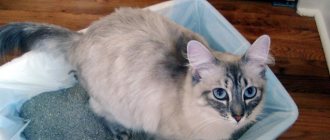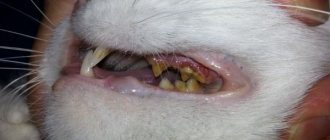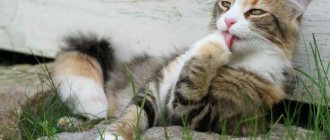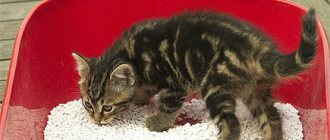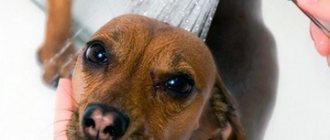A cat constantly licks its tail
If a cat often licks under its tail, this should alert the owner. Various reasons force males and females to lick this place.
If a cat often licks its tail, then this is:
- inflammation of the preputial sac;
- inflammation, injury or cancer of the foreskin;
- urethral diseases (stones, trauma, neoplasm);
- bladder diseases (infections, tumors, stones);
If a cat constantly licks itself, then this should alert the owner
- prostate diseases (prostatitis, tumor, abscess);
- urinary incontinence;
- dysfunction of the sphincter;
- bleeding (coagulopathy) and thrombocytopenia due to rat poison poisoning.
For your information! Cats have a fatty lubricant in their skin that contains cholesterol, which in the sun is converted into vitamin D. By licking, the cat distributes this substance over the entire surface of the body.
Females often lick themselves before and after childbirth, and this is not a pathology. But there are a number of situations where excessive licking is a symptom of illness.
If a cat constantly licks its tail, then this is:
- urinary tract infections;
- inflammation of the uterus and vaginitis;
- tumors of the genitourinary system;
- injury or foreign body in the urinary tract or vagina;
- blood clotting (coagulation) and thrombocytopenia in case of poisoning with rat poison;
- urinary incontinence, sphincter dysfunction;
- retained placenta or death of the kitten during childbirth.
Important! If a cat constantly licks the area near the tail, then the owner needs to pay attention to the discharge from the pet’s genitals. These symptoms will help the veterinarian make the correct diagnosis and treat your pet.
If your cat is constantly licking his tail, you need to take a closer look at other symptoms.
Allergic reactions to foods
The most common cause of itching and skin irritation in cats is food allergies. A cat can become ill from both natural food (for example, meat) and special industrial ones. Popular cheap foods (Kitecat, Whiskas, etc.) cause allergies in many people. It is advisable to choose premium hypoallergenic ones, which are sold only in pet stores.
For your information! Most often, allergies are caused by food proteins, which are found in large quantities in chicken meat, cow's milk and a number of other products.
If a veterinarian has discovered a food allergy in a cat, you need to exclude the dangerous product from the diet and prescribe the correct diet for your pet.
A cat food allergy often manifests itself as inflammation on the skin.
Presence of parasites in the body
External and internal parasites often cause cats to scratch and lick themselves. Fleas, ticks, and lice eaters are especially dangerous for furry pets. They bite the cat and drink its blood, and this leads to the development of allergies and decreased immunity. Ear mites often cause otitis media, a serious disease that can lead to serious complications.
If a cat has parasites in its fur, it will lick them frequently and feverishly. Small blood-sucking insects greatly irritate your pet's delicate skin. Parasites can be easily removed with flea treatment, but you should consult your veterinarian and check your cat for other diseases.
Flea dermatitis
Damage to the skin on the tail
Any owner knows why cats lick themselves. If your cat's tail has wounds or any other damage, it can cause itching and irritation. Having received an injury, the cat begins to lick the sore spot in order to heal it. This way the animals lick any sores. To prevent your cat from doing this, you can put an Elizabethan collar on it.
Unpleasant habit after castration
A situation often arises when a cat licks itself after castration. Every veterinarian knows what to do in this case. He must examine the pet and check for allergies, infections and inflammatory processes.
But is it possible for a cat to lick itself after castration, the answer will be clear - it’s impossible, because the pet can lick the post-operative suture and cause an infection. If the owner overlooked it, and after castration the cat licked a wound under its tail, this requires urgent treatment and re-suturing. To prevent this from happening, a medical collar is put on the cat, which must be worn for 10 days after the operation. The suture should be treated with special medications prescribed by a doctor.
Important! Sterilization is a necessary procedure, but it must be carried out strictly following the rules of hygiene and antiseptics.
After castration, the cat must be wearing an Elizabethan collar.
Dermatitis in cats
Itching and pain of the skin can be caused by dermatitis. This disease is caused by an immune disorder and the activation of opportunistic microorganisms on the animal's skin. Dermatitis is always accompanied by inflammation of the epidermis.
With moderate inflammation, the animal becomes restless, itching, and the cat constantly licks its fur. Suspecting the disease at this stage is quite problematic.
You might be interested in: Why does a cat not open one eye?
In most cases, dermatitis is accompanied by visible symptoms - severe peeling of the skin, the formation of rashes, wounds and erosions. The rashes are most often localized on the pet's face, near the ears and on the neck.
Treatment is carried out using external agents, but only after identifying the pathogen.
Pathological causes of constant licking
This phenomenon can be directly related to some diseases and abnormalities in the animal’s body, namely:
- Gastrointestinal disorders . Excessive salivation occurs due to severe forms of microflora disturbance in the intestines, chronic gastritis or heartburn. Licking and swallowing helps relieve the condition, but only for a very short time.
- Dental problems . Pets over the age of 5 years may suffer from the development of caries, periodontal disease and other abnormalities in the oral cavity. The copious secretion of saliva helps fight pathogens.
- Leftover food . Stuck pieces of food cause some discomfort. In order to get rid of foreign inclusions, a large amount of saliva begins to be released.
- Changing the usual food . New brands may cause an allergic reaction, including excessive saliva flow. Other symptoms include redness and swelling of the eyes, and watery eyes.
If constant licking is accompanied by other suspicious symptoms, you should contact a veterinarian.
In some cases, only timely assistance can save the life of a pet.
Reasons why a cat licks its fur in the absence of parasites
In many cases, a cat constantly licks itself not because of parasites, but for other reasons. The most common of them is stress. Compulsive licking in cats can be compared to the human habit of biting nails. This indicates that the cat is starting to get very nervous. The owner must eliminate the cause of the pet’s emotional distress.
The cat itches, but there are no fleas, it constantly licks itself
Other reasons why a cat constantly licks itself are fungal diseases (lichen), allergies, dermatitis, otitis, and inflammation. The doctor must make an accurate diagnosis and prescribe adequate treatment.
Lichen
Ringworm, or dermatophytosis, is a fungal infection of the skin and fur. The causative agents are fungi of the genus Microsporum or Trichophyton. They affect the roots of actively growing hairs. Characteristic bald patches appear on the head, tail, ears, and paws, and the skin peels off. In the affected areas, the hair can quickly fall out, and the cat begins to go bald.
This disease is very contagious, but is easily treated, does not pose a threat to the life of an animal or a person and does not lead to serious health consequences. Very often, cats with reduced immunity and small kittens get deprived of the disease. The main symptom of lichen is round bald spots covered with scales. If the disease is not treated, then over time the fungi will affect other areas of the coat.
Note! The itching associated with ringworm in cats is usually not severe. If it is accompanied by a skin disease of a bacterial nature, the itching may intensify. Then the cat will constantly itch and lick itself. Scars or scabs may form on the skin.
Ringworm in cats is diagnosed at a veterinary clinic. The doctor makes a hole with a Wood's lamp, takes a scraping from the skin, analyzes wool hairs and inoculates fungi on a nutrient medium. You will also need a blood test to check for infections. Once the diagnosis is confirmed, treatment should begin immediately.
For lichen, the course of treatment lasts a long time (about 3 weeks). In severe cases, recovery takes several months. The pet is prescribed medications for internal and external use. The veterinarian can prescribe medications such as microderm, vakderm, fungin, Yam BK ointment, etc. A sick pet must be isolated from other animals and provided with abundant and nutritious food, rich in vitamins and beneficial microelements. Despite the fact that people do not always become infected with shingles from a sick cat, it is necessary to thoroughly clean and disinfect the apartment.
Vaccinations against lichen are made with the Polivac TM or Vakderm-F vaccines. Vaccination is carried out twice with an interval of 2 weeks.
For your information! If the affected hair has stopped growing, it will not be affected by lichen. Therefore, cats often recover suddenly.
Ringworm in a cat
Dermatitis
Dermatitis refers to a whole group of inflammatory skin diseases in cats. Even a calm and affectionate animal becomes aggressive and restless. Reddened areas appear on your pet's skin, and sometimes a rash appears on them. The affected parts of the skin are very itchy and itchy, which is why the cat may often itch, lick, and even gnaw out fur and skin. Sore spots are hot to the touch. The kitten may meow loudly and lick its lips frequently. Then comes the next stage of the disease, when the skin peels off and becomes wrinkled. Purulent lesions may appear.
Causes of dermatitis in cats:
- allergies to food (preservatives and dyes);
- allergies to shampoos and other chemicals;
- infestation with fleas, lice eaters, ticks, worms and other parasites;
- burn or hypothermia;
- a scratch or bite on the skin;
- infection of already damaged skin by bacteria, development of inflammation;
- individual intolerance to certain drugs, especially oxytetracycline.
In most cases, the trigger for dermatitis is an allergy of any origin. Your cat may be allergic to dust, fungus, or food protein. If a cat's fur is brushed too vigorously, the skin may become damaged and dermatitis may occur.
Important! Dermatitis is dangerous because it often becomes chronic. Symptoms will come and go, and your cat's health will worsen. Deep, non-healing wounds may occur on the skin. Sometimes the cat licks itself and rubs the skin until it bleeds.
If you suspect dermatitis in a cat, you should not hesitate to contact a veterinarian. Only a doctor can find out the cause of the disease and prescribe treatment. First of all, you need to get rid of the allergen that triggered the development of dermatitis. To do this, you will have to replace food, shampoo and other household items. The veterinarian will help you choose the appropriate food.
Dermatitis in a cat
Endocrine system disorders
Excessive licking may be a sign of endocrine dysfunction in cats. The veterinarian performs many diagnostic tests to find out what exactly is causing these symptoms. Knowing the cause and mechanism of development of hormonal imbalance, the doctor will prescribe suitable treatment for your pet.
Otitis
Otitis is an inflammation of the middle ear in cats, often leading to dangerous complications. Pets suffer from otitis media much more often than people. If the cat begins to scratch its ear frequently and intensely and shakes its head, otitis may be suspected. The skin on the inside of the ear appears irritated, red and swollen. Treatment must be started immediately, otherwise purulent otitis may develop.
For your information! In the purulent form of the disease, a thick, dark brown liquid with an unpleasant odor is released from the ear. This disease causes severe pain to the cat. In severe cases, inflammation of the facial nerve may occur, then the pet's ear, eyelid or lip sag. Further inflammation affects the vestibular apparatus and brain. Because of this, the cat may die or remain disabled.
Otitis media in cats can be caused by parasites (especially fleas and ticks), bacteria, fungi, allergies, trauma, and foreign bodies in the ear. Hypothermia can also cause otitis media. Therefore, if the cat is cold or caught in the rain, it must be warmed up and kept in a warm room. Water that gets into the ears is very dangerous for your pet.
Diagnosis and treatment of otitis should only be carried out by a veterinarian. He will prescribe a course of treatment from a variety of drugs. Taking good care of a sick pet will keep it alive and healthy.
Otitis in a cat
Skin diseases
In addition to dermatitis of various origins, there are many other skin diseases of cats. Parasites can cause diseases such as demodicosis, scabies, and eczema. Ringworm and eosinophilic granuloma are especially widespread.
Dermatomycoses are a group of fungal diseases that affect the fur and skin of cats. Ringworm is a type of dermatomycosis. Treatment must be strictly under the supervision of a veterinarian.
Eosinophilic granuloma affects the lips and oral cavity. The disease manifests itself in the form of redness, swelling and hair loss at the site of the lesion. Pain and itching are rare, but the cat may lick the sore area frequently. The veterinarian diagnoses the disease and prescribes treatment. Eosinophilic granuloma is treated for a long time, but successfully and has a favorable outcome.
Skin diseases take a long time to cure
Important! Sometimes it happens that a cat licks its belly until it becomes bald. The reasons for this lie in severe stress, a fungal infection or skin parasites. If a cat licks itself a lot and begins to go bald, you need to take it to the veterinary clinic.
Bald patch on paw due to lichen
Why does a cat lick its fur in different places, but the animal has no fleas?
The presence of fleas in a pet is the first thing a cat owner thinks about if he notices that he is constantly licking his fur. Even if a quick examination did not reveal parasites in the fur, this does not mean that they are not there. Nits are not so clearly visible; they look like black, very small dots on the skin between the hairs.
READ What to do if your cat has crusts on her ears?
However, the cause of constant licking of fur can be not only fleas, but also other skin parasites - scabies mites. It is quite easy to identify them by such signs as the presence of lesions on the skin in the area of the ankles, ears and elbows.
Constant licking of a cat's fur in the absence of parasites may be an initial sign of one of the pathological conditions:
- depriving;
- dermatitis;
- endocrine system disorders;
- otitis;
- skin diseases - demodicosis, pyodermatitis.
All these pathologies, in addition to constant licking, are accompanied by other symptoms - the presence of wounds and erosions on the surface of the skin, areas of severe peeling.
Infection of the skin with lichen forces cats to clean their toilets more carefully than usual. If the owner notices that his pet has begun to lick its fur most of the time, you need to carefully examine its skin. If there is lichen on the skin, pockets of erosion or scabs will be visible between the hairs.
With fungus everything is much more complicated.
But there are a number of signs that an attentive owner will notice:
- excessive dry skin;
- the skin in certain areas changes its color, becomes paler or, conversely, stands out excessively, becoming darker or brighter by several tones;
- the appearance of gray scales that separate from the skin;
- the fur becomes thinner.
Similar signs may be present in other skin diseases, so it is not possible to make a diagnosis without a veterinarian.
Dermatitis
Identifying dermatitis in a cat is no less difficult a task than diagnosing a fungal infection. A cat will constantly lick its fur because it suffers from an incessant feeling of itching and burning. One of the most pronounced signs of dermatitis is the presence of inflammatory processes on the skin.
It is almost impossible to determine the presence of dermatitis at an early stage of its development, therefore, if the owner notices that his cat has clearly begun to lick itself longer and more often, it should be immediately shown to a veterinarian.
An ear infection is always accompanied by severe itching. The cat will lick itself vigorously, damage its face and ears with its claws, and constantly shake its head. Other signs include redness of the inside of the ear, swelling and pus discharge.
Demodecosis and pyodermitis are pathologies of the skin that are accompanied by severe and constant itching, while the cat experiences severe, ongoing discomfort. Due to the incessant “mange”, the cat begins to lick its fur and sometimes does it so intensely that bald patches appear on the fur.
READ Lumps on the abdomen under the skin of a cat: what kind of tumor is it?
Symptomatic treatment
You need to start by finding out the causes of the phenomenon. If these are medical problems, then they need to be addressed with the help of a veterinarian. You should consult a doctor if your animal regurgitates hairballs too often, licks itself until bald patches form, and various rashes and scratches appear on the skin.
The veterinarian will assess the cat’s condition and conduct the necessary examinations. For example, in case of receding hairline and scratching until it bleeds, a specialist will definitely do a scraping and take a blood and urine test. If internal pathologies are suspected, the specialist will conduct an ultrasound and computed tomography.
Once the diagnosis is made, the veterinarian will prescribe treatment. If you strictly follow all the veterinarian’s recommendations, then recovery will come quickly, and intense licking will pass.
Diagnostic measures
How to stop a kitten from biting: reasons for this behavior
To correctly determine the reason why a cat licks itself too often, the veterinarian performs a number of diagnostic procedures. To diagnose lichen, a Wood's lamp is used. After this, the doctor takes scrapings from the sore spot and damaged hairs from the cat. Then the skin sample taken is inoculated onto a nutrient medium. Additionally, blood is taken from the cat to test for infections. All procedures together will help you find out the cause of the disease and heal your pet from the disease.
A cat's fur is examined with a Wood's lamp to diagnose lichen.
What is overgrooming in cats?
Overgrooming in cats is a rather poorly studied pathology, characterized by excessive licking of certain areas of the body, as a result of which the hair in these places becomes thinner, and then bald spots are formed - areas of open skin, sometimes with the presence of wounds.
Cat owners need to know that overgrooming often occurs in animals due to psychological reasons.
With this disease, the cat can not only lick, but also bite the skin so that wounds appear. If you do not treat your pet, painful licking can even lead to the amputation of a part of the body.
Cat owners need to know that overgrooming often occurs in animals due to psychological reasons, usually associated with the cat experiencing stress.
Due to the current lack of serious, in-depth research into the causes and treatment of the disease, adjusting the behavior of cats is a long process , in parallel with which the pet’s skin is also treated.
What parts of the body are at risk?
Completely different areas of the body can be overgroomed, but most often cats lick:
- stomach;
- the inside of the hind legs;
- front legs;
- underbelly;
- lateral parts of the body.
Treatment of overgrooming in cats
Important! Only a specialist can cure dangerous licking of a cat’s fur.
The veterinarian, after examination and some research carried out on the basis of tests, can determine the root cause of the disease. If overgrooming occurs as a result of stress, correction of the animal’s behavior is prescribed by a zoopsychologist.
If the disease is caused by an allergy, then after tests and a conversation with the owner, this product is excluded from the animal’s diet. In especially dangerous cases, when the cause of the disease is infection of the cat’s body with parasites, the doctor prescribes antihistamine therapy.
Licking to the point of baldness
The owner of a purring dog may not even realize that constant, almost non-stop licking of fur is a symptom that the pet is in a state of psycho-emotional instability.
As a rule, all owners are accustomed to the fact that cats lick themselves because they have dermatitis or parasites, but it is also possible that the cat is experiencing real emotional torment. This picture can be observed when an animal needs to mate.
In order to normalize the pet’s condition, after which, accordingly, the bad habit of constantly licking the fur will go away, it is enough to give the cat to drink medications that have a sedative spectrum of action. But it should be borne in mind that they must be taken carefully so that they do not cause side symptoms or addiction in the pet.
READ How many years do Scottish Fold cats live, Scottish Straight life expectancy
Therapeutic measures
A cat hisses: the main causes of aggression
Any skin, parasitic or endocrine diseases should be treated immediately. The duration and method of treatment depends on the cause of the disease. If you have an allergy, you need to adjust your diet and remove the allergen. Ringworm is treated with antifungal ointments and tablets. For inflammatory and infectious diseases, a course of treatment with antibiotics and anti-inflammatory drugs is prescribed. Regardless of the cause of the disease, treatment always takes a long time: from 3 weeks to 2 months. It is necessary not only to help the cat stop itching, but also to completely eliminate the infection.
Treatment is prescribed depending on the cause of the disease
Is it dangerous?
Frequent licking of a pet's fur should alert the owner. The following symptoms indicate the development of overgrooming:
- the appearance of bald patches in different parts of the body;
- areas with sparse hairs that often break;
- deterioration of the coat condition;
- signs of allergies;
- scratches, ulcers and other wounds on the skin of a cat that take a long time to heal;
- lethargy, apathy and reluctance to eat.
If the problem is neglected, it threatens to affect more areas on the animal’s body.
If you do not carry out treatment in time and do not get rid of the problem in which the cat licks the fur down to the skin, then there is a high probability of multiple bald spots appearing, which will deteriorate the appearance of the pet. When overgrooming, there is a risk of infection in the wounds, as a result of which an acute inflammatory process progresses in the deep structures of the epidermis. When a cat not only injures the skin through frequent licking, but also chews it out in pieces, necrotic lesions appear. Overgrooming is a common cause of disrupted natural hair replacement process.
Symptoms of the presence of parasites
Animals show increased attention to their own hygiene in the presence of parasites - fleas or ticks. At the same time, the cat is constantly itching, shaking itself off and licking itself. You can suspect parasites by carefully examining the animal's fur.
If no fleas are found, it is recommended to inspect the coat again, paying attention to the areas behind the ears and on the neck. A possible cause of discomfort may be nits, which can be difficult to detect with a quick examination. Excessive peeling of the skin in the absence of visible parasites may indicate a mite.
As a rule, with such diseases, the animal constantly tries to gnaw something out of the fur, simultaneously licking different parts of the body. Treatment is carried out using special anti-parasitic drops.
You might be interested in: Why does a cat constantly stick out its tongue?
Preventive actions
Fungal and bacterial infections can be prevented by practicing good hygiene. Special medications and treatments will help protect your cat from lichen, dermatitis, otitis media and other diseases. For prevention, you need to regularly treat your pet against fleas, ticks and fungi, and also wash the bowl and tray with disinfectants. Bathing with a special shampoo is beneficial for cats. This procedure only needs to be done once a year.
Important! After treating a kitten with anti-flea or anti-fungal products, the animal should not be bathed. It is forbidden to wet the area where the medicine was applied.
The cat licks itself to help itself
Sanitizing the tray and bowl
All items belonging to the cat - bowl, tray, toys, etc. - must be regularly washed and treated with disinfectants. This will protect your pet from infectious, fungal, viral and other diseases. The bowl can be washed with regular dishwashing detergent. Usually fungus does not form on a cat's bowl, most often in the tray. It is advisable to treat it with any antifungal spray against lichen. Additionally, you can treat the tray with camphor alcohol, which not only cleans and disinfects the surface, but also eliminates unpleasant odors.
The bowl and tray should be washed and disinfected regularly
Special flea products
There are many treatments available at pet stores for fleas and other external parasites. They are available in the form of drops on the withers, sprays and collars. It is advisable to treat the cat with drops on the withers; this is the most effective remedy. The room can be sprayed with flea spray. Flea collars are not very effective. It does not destroy insects, but only repels them. A collar can only be put on a cat if it has recently been treated for fleas. Flea drops such as Leopard, Frontline, Advantage, Inspector, and Bolfo spray are very effective.
Flea remedies
How to prevent a bad habit
The fact that an animal licks itself non-stop after sterilization is a normal, understandable phenomenon. After surgery, when the incision scar begins to heal, this process is accompanied by severe itching and burning. It is not surprising that the cat will try to relieve discomfort by constantly licking the skin.
But it is important for the owner to understand what this can lead to. If the suture is constantly wet after surgery, this will lead to poor and too slow healing and increase the risk of secondary infection.
Constant licking of fur is always associated with the fact that the cat develops itching of various etiologies on the skin. Its occurrence can be prevented by taking preventive measures:
- The good health of a pet depends primarily on its owner, who must regularly sanitize the cat's litter box and food bowls.
- Don’t forget about antiseptic treatment of pussy ears using special products. This way you can prevent the appearance of lichen and fungal infections.
- To prevent fleas from appearing, the cat needs to be bathed regularly, the fur must be treated with special preparations, and a special flea collar must be put on the pet.
- It is recommended to carefully approach the issue of choosing industrial food and natural products so that your pet does not develop allergies.
- You can prevent excessive dryness of the skin and its peeling, which is why the cat begins to constantly lick itself, by choosing the right hygiene products for bathing - they should be specialized, in no case human or even children's.
Proper care of your pet and sufficient attention is the key to ensuring that the cat feels good, both mentally and physically.
Category: Interesting things about cats |
by redaktorporodakoshki
Symptomatic diet and procedures
The best treatment is prevention. Therefore, to prevent the occurrence of this symptom, it is important:
- Regularly wash the cat's food and drink bowls, clean the cat's house, bedding and carpets indoors.
- Regularly inspect your cat's fur, comb it out and remove tangles.
- Clean your cat's ears and keep them clean.
- Supplement the daily diet with vitamins and microelements, especially if the cat has recently been ill and its body is weakened.
- Do not allow your pet to come into contact with dirty street animals.
- Give your pet enough attention and don’t forget to caress her.
You can help the animal solve psychological problems on your own. There is no need to lock your cat in a small room. If you are going to the country for the summer, take your pet’s house with you. After moving or adding another animal to your home, try to spend a little more time with your pet at first. If you help a cat realize its predator or hunter instinct by playing with it for at least 20 minutes, it will be easier for the animal to cope with stress.
Cats love platforms raised above floor level. They consider them a good place to retreat in case of danger. They can sit on these sites, experiencing moral discomfort. It’s good if you can equip a pet house on one of the sites. If necessary, the cat can retreat and survive stress in a secluded place.
Why does a cat lick its fur more than necessary?
Allergy to food
One reason may be an allergic reaction to food. For example, dry food may contain plants that cats do not naturally eat. Consult with experts and choose food suitable for your cat.
Itching and parasites
The cat licks areas of the body where it is itchy or painful. Licking in the anal area can be caused by constipation. Sick areas are licked more “targeted” than itchy areas. In case of itching, the licking area exceeds the size of the itchy area. The appearance of bald patches provides clues to the cause of excessive licking of fur.
Skin wounds
Cats lick scratches and other skin lesions. This is a normal process that cleanses the wound. In nature, a cat has no other way to take care of itself. However, this may be undesirable when the wound is treated with some kind of ointment or a suture is applied. To prevent unnecessary licking, you should limit your cat's access to the affected area.
Cats really don’t like closed doors, where they used to go freely. The cat is worried, not knowing what is happening in the closed (its!) territory. Additionally, while cats can get by with a small living space, it shouldn't be too small. Perhaps any of us would begin to tear our hair out, being locked in an apartment for years 24 x 7. We consult with family members when making any decisions. And although we cannot consult with a cat, we are quite capable of taking its interests into account.
Excessive licking is not always associated with a cat's physical health. Its cause may also have a psychological basis. Cats like their lives to be predictable and orderly, so unexpected changes can be stressful, says Dr. Perry. Reconstruction of the apartment, the appearance or disappearance of other animals, and sometimes even a change in regime cause anxiety in cats.
READ Childbirth in a cat signs of complications how to help a cat give birth
It happens that people try to force a cat to live by their own rules and do what they see fit. Such tricks do not work with cats - she is a free animal (conditionally domestic), she cannot be defeated, you can only come to an agreement. It is necessary to take into account her interests, creating as many opportunities for the cat as possible to satisfy her natural needs.
Licking in such cases is considered “replacement behavior” (people in such cases behave similarly, for example, biting their nails) - it calms the cat, but at the same time can become habitual if the source of anxiety is not noticed and eliminated in time.
If all medical problems are resolved, then treatment for excessive licking as a result of some form of stress in the cat's life is necessary, says Dr. Perry. If possible, changes should occur gradually, while maintaining elements of the environment familiar to the cat. For example, when moving, you need to take the cat house with you.
Provide elevated platforms that cats love - they make the cat feel safe and are perceived as possible escape routes. Help your cat show its hunting instincts by playing with it for just 10-15 minutes a day. Most cats love to be played with.
In addition, licking gives cats some pleasure. Thus, excessive licking can become a habit that continues after the cause is identified and addressed. Typically, a cat's fur licking returns to normal (on its own or after assistance) within a month.
With both physiological and mental causes of licking problems, resolving them takes time and patience. With proper attention and care, the cat's fur is restored and life returns to normal.
Prevention
Adviсe:
- Regular preventive maintenance helps prevent illness, the living area is cleaned, the floor is washed, dust is removed, and the cat's bed is always washed.
- The bowl is kept clean and the drinking water is fresh.
- Ears are regularly cleaned and treated with antibacterial agents.
- Veterinarians advise using only high-quality food.
- Communication with other animals is limited.
If the kitten is itchy and there are no fleas, it will be examined by a veterinarian.
Preventive remedies for worms:
- Cestal cat is an anthelmintic medicine taken orally, once. The tablet is placed on the tongue or dissolved in water.
- Dirofen in gel or tablet form is taken in the morning from three weeks of age.
- Milbimax for young and adult animals, the dosage is determined by veterinarians.
Sedatives:
- Fospasim is taken for stress during moving, aggressive behavior, and fears. It is produced in the form of tablets and solution for injection.
- Bach drops are often given to animals at shows, dissolved in water, and injected into the mouth with a syringe.
Immunostimulants and restorative drugs:
- Gamavit contains many useful microelements, vitamins, stimulates metabolism, increases the chances of survival in weak individuals. Injections are given under the skin and into the muscle.
- Catozal is prescribed for problems with metabolism, disorders of the reproductive system, prevention of infertility, and exhaustion of the body. The medicine tones and normalizes metabolic processes.
- Imunofan is used to strengthen the body's protective functions and treat respiratory diseases; it is injected every 3 months.
- Ringer-Locke for dehydration, bruising, for cleaning ears and eyes, a general strengthening drug.
- Evinton treats viruses, stimulates the immune system, and is prescribed for rhinotracheitis, gastroenteritis, complications after vaccinations, and allergies.
- Cycloferon for plague, enteritis, calcevirosis, rhinotracheitis, chlamydia.
Medicines that help with injuries:
- Traumatin is injected into the muscle and under the skin, used for fractures, dislocations, skin damage, relieves pain during childbirth, helps get rid of shock, stops bleeding, stimulates healing.
- Monclavit is an extended-spectrum antiseptic for topical use that leaves no residue on the coat.
Medicines used during childbirth:
- Mastomethrin for inflammation and problems with the reproductive system, postpartum complications, normalizes uterine contractions, destroys pathogenic microflora, and is not used during pregnancy.
- Calcium borogluconate for eclampsia, shock, rickets, before the injection it warms up to 39 degrees, causes pain.
- Oxytocin is a hormonal substance that is injected carefully and is not used before childbirth.
Anthelmintics are used on the recommendation of a veterinarian every 3-4 months.
How to treat?
Constant licking of fur down to the epidermis is not normal and requires therapeutic measures. It is impossible to eliminate the problem without finding out its original source. To do this, contact a veterinarian who will conduct a diagnosis and select medications if necessary. Drug treatment is required for atopic dermatitis. To eliminate itching, the following medications are prescribed for cats:
When a pet licks its fur to the skin under the influence of stress factors, the cat needs to be provided with peace and surrounded with care. If pathological licking occurs against the background of an allergic reaction, then the influence of the irritant on the cat’s body is immediately excluded. If the violation does not go away, then additional antihistamines are prescribed. To combat the problem caused by small parasites, pet hair is treated. For this purpose, you can use antiparasitic drops, tablets or sprays.
Reasons why a cat licks its skin a lot
Possible diseases
Wounds in the tail, belly and other parts of the body that the pet actively licks until blood appears can be the result of serious diseases. Pets often chew out their skin when the following pathological processes develop:
- invasive type deviations;
- diseases of the endocrine system;
- impaired metabolism;
- idiopathic syndrome in cats;
- pathologies associated with improper functioning of the excretory system;
- damage to internal organs located in the abdominal cavity.
Veterinarians warn owners that if a cat licks its fur down to the skin, this is a consequence of hormonal imbalance. A similar phenomenon is often observed during estrus or in a cat during pregnancy. If necessary, contact a specialist who will prescribe hormones.
Impact of stress
A state of stress can develop in a pet if the owners decide to change their habitual housing.
Sometimes a cat pulls out its fur and constantly licks its back due to a disturbed emotional state. The following factors can trigger stress:
- change of housing;
- relocation of one of the family members;
- loss of a frequently used toy;
- the appearance of another pet;
- sudden transition to a different diet.
Activity of ectoparasites
With frequent licking of fur, owners first need to examine the pet and find out if it has ticks, fleas, lice and other small parasites. In this case, the cat constantly chews out its paw and other parts of the body, trying to get rid of severe itching and discomfort. If you detect the activity of ectoparasites and bald patches on a cat’s fur, you should contact a veterinary clinic, where the owner will be told how to treat the animal. To prevent the problem of a cat licking its fur down to the skin, it is recommended to regularly treat your pet with special products.
Dermatological diseases
Often, a fluffy dog behaves this way when it has developed a skin disease.
Often the reason why cats lick their fur down to the skin is due to skin diseases. Thus, the animal tries to lick the wounds and restore the integrity of the epidermis. This behavior is observed on an instinctive level. If the owner notices a dermatological disease in time and tries to help the cat with special ointments and other external means, then it is worth not allowing the pet to lick the fur. For this purpose, use a collar or bandage the treated area with sterile cloth.
Allergic reaction
It is not uncommon for a cat to bite the skin and tear out fur when experiencing an allergy, accompanied by redness, itching and discomfort. A similar reaction occurs in domestic animals to the following stimuli:
- house dust;
- some plants;
- household chemicals.
Often this symptom is a reason to change the furry's diet.
Most often, the cause of allergies, due to which a cat licks its skin, is the consumption of certain foods. As soon as owners notice the appearance of bald spots, they should immediately review the pet’s diet. Perhaps some components of the feed are not suitable for the animal, then the product should be replaced with another. If nutritional correction does not produce positive results and the cat continues to lick its fur, then the veterinarian will prescribe medications with antihistamine effects.
